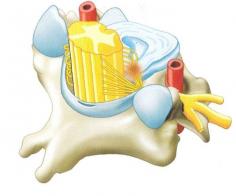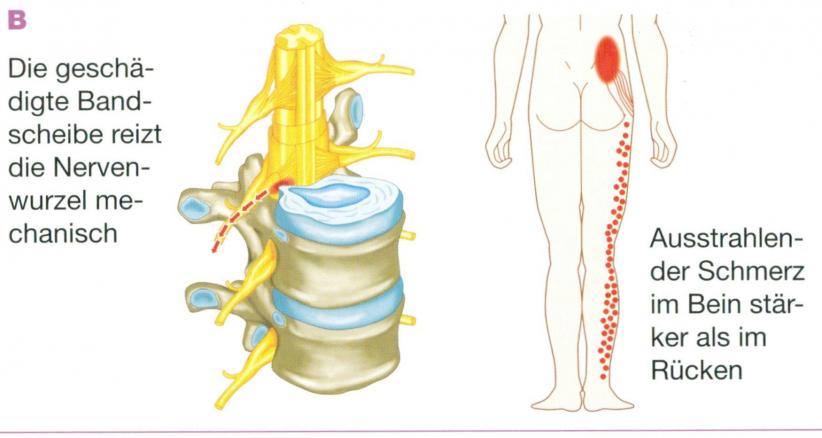You are here: Home » Diagnosis » Disks
disks
Pain which has its origin in the lumbal spine can have many different reasons. Due to the fact that all structures which can cause the pain are closely related to each other it is very important to bring a lot of experience in the clinical diagnostics. Due to the character of the pain it is possible to differentiate in different categories.
Pain which has its origin only in the lumbal spine (Lumbago)
A swelling of the vertebral disk which then depresses the ligamentum longitudinale posterior, a ligament which connects all vertebral bodies from the back and contains a lot of pain receptors. An arthrosis of a vertebral joint. If the pain radiates down to the strip t is more likely that the origin of the pain is due to a degeneration of the bony structures.
Lumboischialgia:
If the pain radiates into the leg it is very likely that a slipped disk depresses the nerval root. There is the possibility that nerval damage increases which could lead to paralysis. Please try to stand on your toes while standing on one foot. Other ways to check for a lumboischialgia is to walk on the heels or to check the ability to climb stairs.
Emergency:
If the nerves of the spinal canal experience strong pressure this can lead to a disfunction of the bladder and the rectum, paralysis or numbness at the region of the grundle (perineum). These symptoms are a sign for an acute neurological emergency case which must be treated as soon as possible.
“Why me of all people?“
These same question we got confronted with nearly every day during our consultation time. It is nearly impossible to find an unique answer to this question. There can be many different factors which together may be the reason for a slipped disk. Most patients bring up the question if it could have been happened due to their jobs but this is only one of multiple factors.
Incorrect movements:
The human evolution optimized the human body for constant movements but not for peak or too less movements. There are only some movements which really harm the body. It is more likely to experience an acute slipped disk if you have to lift heavy objects very frequently. If you try to perform a rotation movement in addition to the heavy lifting this can easily cause a laceration of the intervertebral disk.
Attrition:
Nobody would be astonished if the vehicle axis of your car break after 200.000 km or the exhaust pipe breaks apart. If it comes to similar symptoms of attrition of our body we react terrified or scared which is more than understandable. But similar to our car the human body ages and gets damaged through use. The ligaments weaken as well as the intervertebral disks and it could come to attrition of the joints. Some scientist brought up the theory that the evolution created the human body for a lifespan of around 40 years. During the past million years this was enough for the human evolution but the life expectancy increased a lot during the last 200 years but the body has not yet adapted to this new conditions.
Gravity:
The gravity is a force which acts on the body all the time and drags us down. Due to the fact that humans walk in upright position the entire force of the gravity gets compensated by the intervertebral disks.
Accident:
It is more than logical to link a slipped disk to any kind of accident. Insurances come to us with this question very often. We use 3 different criterions to relate the slipped disk to an accident.
The accident must have been severe enough to cause the slipped disk.
There must be a chronological connection between the event and the disease
Similar pre- existing conditions must be excluded
In the case of acute nerve damage with paralysis or emotional loss, we will promptly perform an X-ray and assess it on the same day.
Even acute pain will be treated immediately!
With years of pain, the treatment is more complicated as pain memory has already developed.
In any case, you will receive our practice an individual treatment concept. This is usually built in stages, each step is discussed with you.
The prognosis always relies on the differentiation between a nerval irritation or a nerval damage.
Nerval damage:
If it comes to a nerval damage it is necessary to start the treatment as fast as possible to prevent a further destruction of the nerve. As longer the damages remains untreated as lower is the chance that the discomfort gets reduced. Another negative effect of an untreated nerval damage is that it can result in long lasting pain which leads to a neuropathic pain syndrome.
Pain:
If the patient suffers from a pure pain syndrome which could appear due to a slipped disk it is possible to wait, see and treat conservatively. Based on our experience most of the pain can be completely removed if the treatment gets indicated properly. It is highly important that the pain gets treated as fast as possible to prevent the development of a pain memory. With the current medicine noone has to live with pain because nearly every pain is treatable. The current state of research shows that the pain memory starts to develop after six weeks which means that the pain which was originally caused by a slipped disk can last longer even if the physical cause has already been removed.
The conservative therapy or the non- operative therapy contains the following:
medical information about the causes
medical information about the behaviour
if necessary: information about a chronic pain syndrome
drug treatment including a procedure to relax muscles
therapy including TENS
physiotherapy
acupuncture
specific penetration
In most of the cases we will create a step-by-step therapy in the beginning of the treatment which has very little side effects.
We are very reserved and strict with the indication for an operation, that is why we only operate when no other option is possible. Previously we have an abundance of other conservative and operation- preventing possibilities to treat a patient.
Depending on the diagnosis and the severity of the disease the surgeon can choose from many different options for the operational therapy. With the time all these procedures got more and more gentle.
Percutaneous Laser Disk Decompression (Sclerotherapy)
Percutaneous Laser Disk Decompression (Sclerotherapy)
Nadel mit Laserfaser
Nadel mit Laserfaser
With the help of an X-ray the surgeon inserts a thin needle into the intervertebral disk. Due to the administration of analgetics the entire intervention is nearly pain free. By the help of the needle the surgeon can then insert a glass fiber which carries a laser. The slipped disk can then be vaporized by a laser.
Microsurgical operation
The operation gets performed by the help of a special operation microscope. The surgeon prepares a minimal opening which has a diameter from 1-2 cm. Following this the surgeon can either dissect the slipped disk or dilate the spinal canal.
After a microsurgical operation the patient is allowed to stand up and walk again which is even helpful for the further healing process. In most of the cases the patient has to stay in the hospital for 1-4 nights.





